Thomas Müller established himself as one of Germany’s best young talents in the 2009/10 season under Louis van Gaal at Bayern Munich. His stock rose after he won the Golden Boot at the 2010 World Cup at only 20-years-old. He was becoming an integral part of Bayern’s team and was crucial in Die Roten’s historic treble campaign in the 2012/13 season. The following summer, he scored five goals to help Germany lift their fourth ever World Cup.
During this time, he was regarded as one of the best players in the world and became the inventor of a new footballing role – the ‘Raumdeuter’. Müller’s eccentric style of play caught the attention of the world as he was able to find space and use his high footballing IQ to have a positive effect on his team. He continued to flourish under Pep Guardiola contributing to a lot of goals and cementing himself as a legend at the club he grew up supporting.
However, following Germany’s shocking group stage elimination in the 2018 World Cup, questions were being asked of whether the versatile attacker could still deliver at the highest level. Die Mannschaft’s manager Joachim Löw axed him from the national team squad just a couple of months later and Müller later also found himself out of favour at club level under Niko Kovac.
This season, following the dismissal of Kovac, Müller has proved his doubters wrong with Hansi Flick’s tactics managing to get the best out of one of football’s most unique players. This tactical analysis will look at Müller’s renaissance under the new coach and how he is once again, a key player for the reigning Bundesliga champions.
Consistent position
The 30-year-old has played in a lot of different positions throughout his career and the same goes for this season, which showcases his tactical flexibility and highlights his footballing IQ. Under Niko Kovac, Müller was mostly deployed as either a centre-forward or an attacking midfielder behind Robert Lewandowski. During the Croatian’s short stint this campaign, Müller only contributed to four goals in ten games. Meanwhile under Flick, the German has an incredible goal contribution tally of 17 in 14 Bundesliga games. This is partly down to Müller featuring more often as a right-winger – his preferred position.
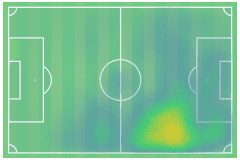
The heat map is what you would expect from a winger but there are some interesting signs. There is quite a lot of action in the box for someone who is supposed to be playing out wide. In addition to that, the map also shows that Müller likes to drift into the right half-space, which usually occurs when Benjamin Pavard pushes forward from right-back. When he is in that half-space, he likes to make a darting run in behind the defence into the opposition box and then look for a cutback to Lewandowski or onrushing midfielders. Since Pavard is the defensive full-back out of him and Alphonso Davies, it gives Müller a lot of space to work with on the right-hand side. The right-wing position also takes advantage of the forward’s ability to deliver great crosses into the box. This is important for Bayern as they lost one of their key creators in Joshua Kimmich who was able to garner a lot of assists from right-back but has now moved to central midfield to give Bayern balance in the middle of the park.
The ‘Raumdeuter’ role
Müller is the inventor of the Raumdeuter role which is a German term that translates to space investigator due to his superb ability to create and move into space. Over the last few years, Müller himself admitted that he was not able to find space as he used to but Bayern’s system under Hansi Flick has allowed the 30-year-old to rediscover his ability. Flick was Joachim Löw’s assistant manager for Germany and thus, knows Müller’s strengths and weaknesses as a player. As mentioned earlier, the manager deployed the versatile forward as a right-winger, which allows him to have a little more space to work with. However, such is Müller’s ability to play the Raumdeuter role and Bayern’s fluidity in their attack, the German is able to find and create space in the final third with relative ease.
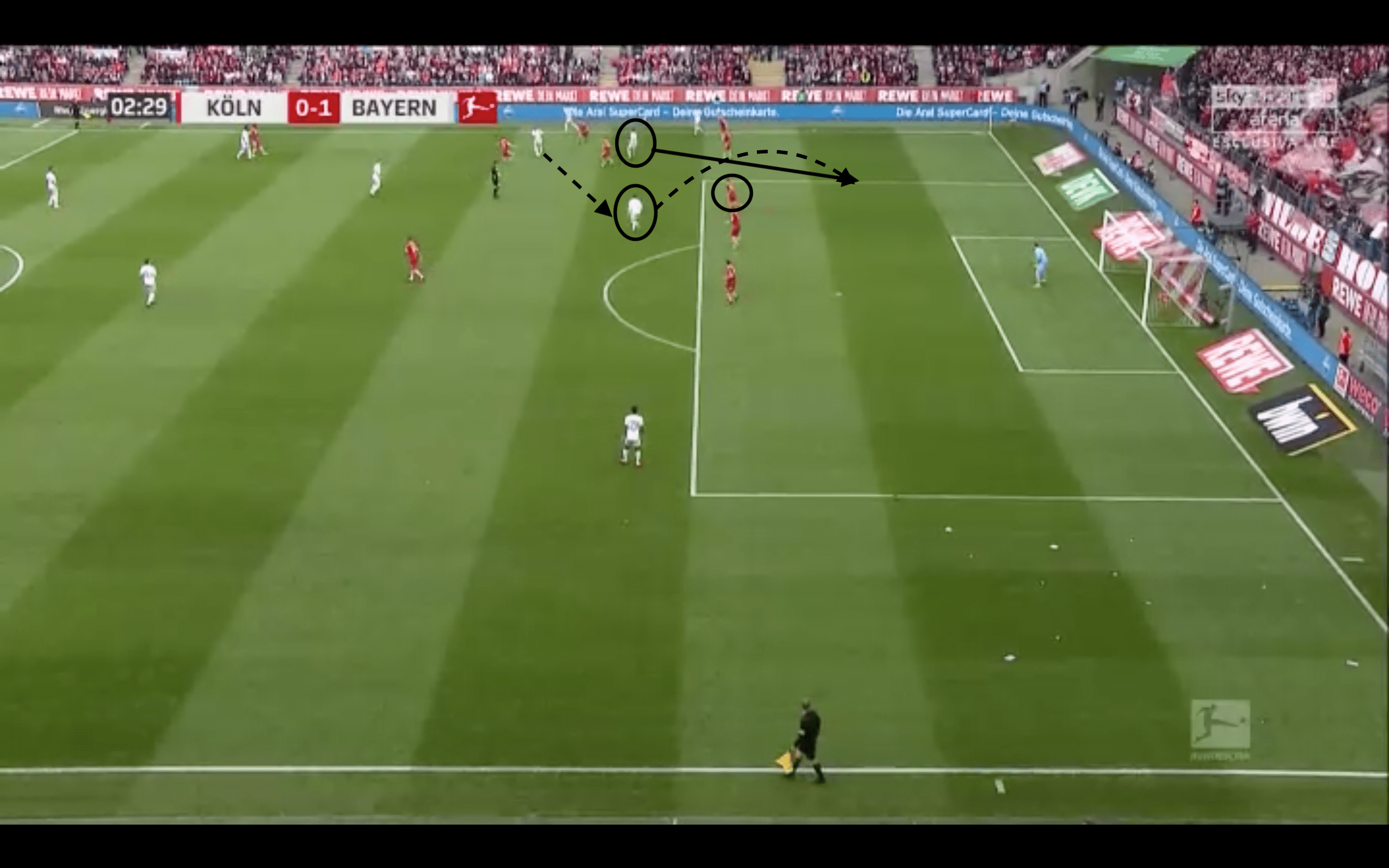
Here, Müller is able to find a large amount of space in front of the Köln defence. Thiago plays the ball into his feet, which attracts the opposition defender to Müller because of his imminent threat. Unfortunately for the defender, the German was one step ahead and noticed Robert Lewandowski’s movement. He played the ball into the path of the striker who moved into the space that the defender vacated and scored the opener.
Müller is able to find pockets of space in between the lines especially when playing as an attacking midfielder. However, he finds space more often by drifting into half-spaces and capitalising on the opposition defence’s lapse in concentration.
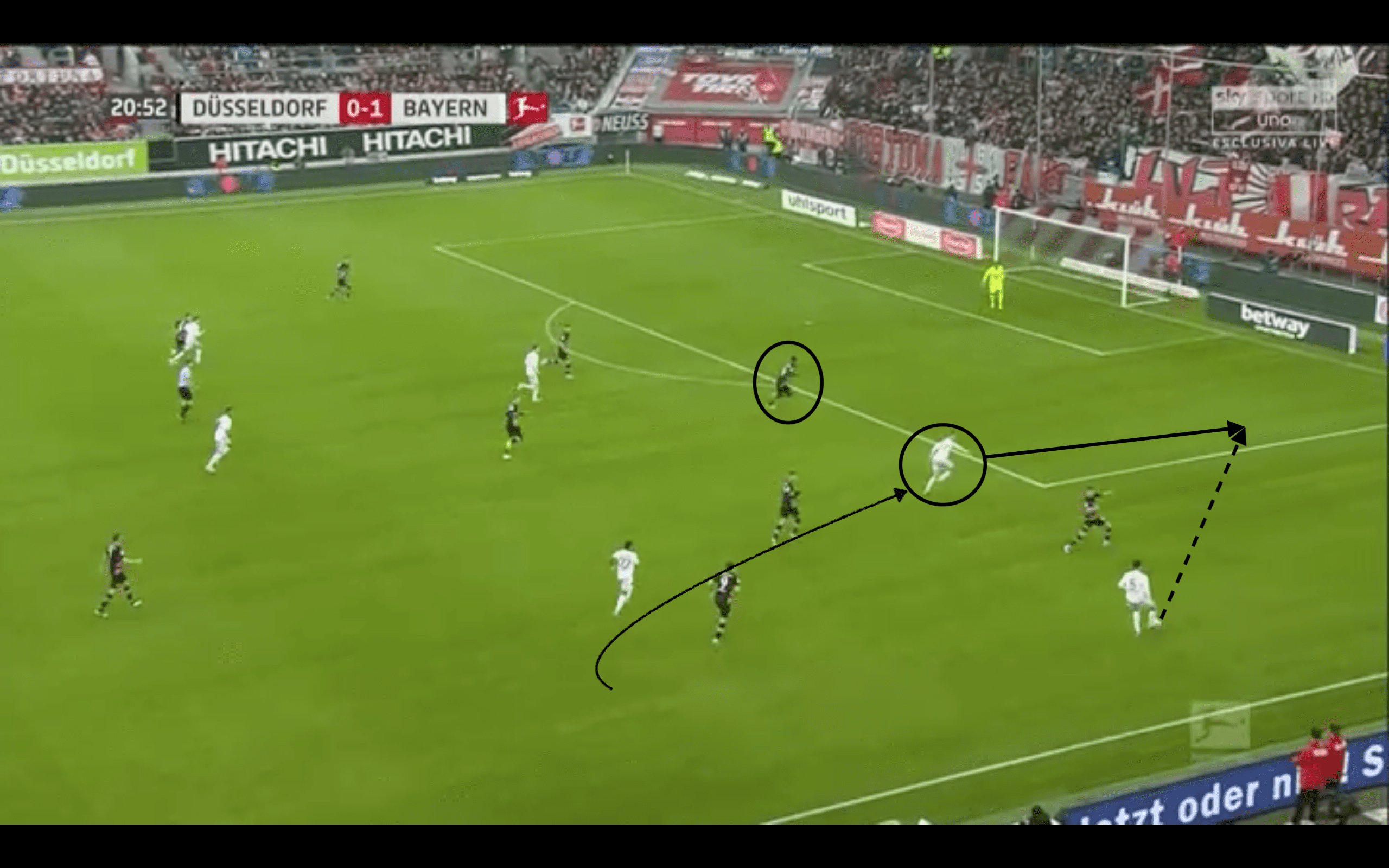
In this example, Müller drifts into the half-space from a deeper wing position and is able to wedge himself between two defenders and make a darting run. His run attracts the last defender, circled, leaving a lot of space in the area for Lewandowski to attack. In the end, Benjamin Pavard’s through ball went too wide meaning that the keeper was able to get to Müller’s cross before Lewandowski. Müller’s combination play with the right-back when he is in the right half-space is one of Hansi Flick’s go-to combinations in Bayern’s attacking build-up.
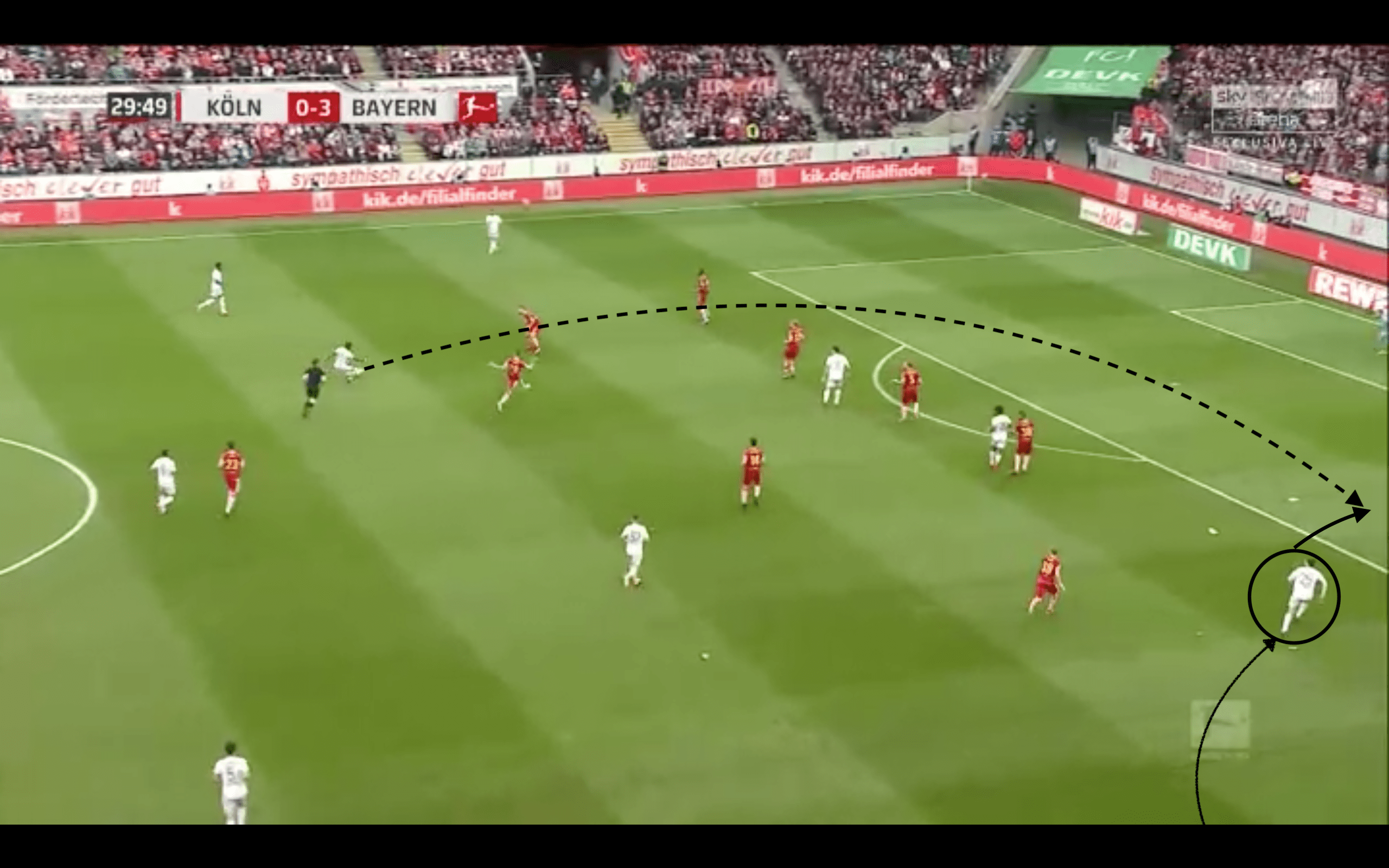
Here is another example of how Bayern use Müller’s ability to drift into the half-space. The German is able to get into the area without being noticed by the opposition as their defenders are all focused on David Alaba who has the ball. The makeshift centre-back recognises Müller’s movement and is able to find him with a great long ball. Müller takes advantage of the space and is able to control the ball and lay it off to Kingsley Coman. However, the Frenchman was unable to connect with the cross. Under Flick, Die Roten are fantastic at creating chances with Müller one of the key players given his brilliance at playing the Raumdeuter role.
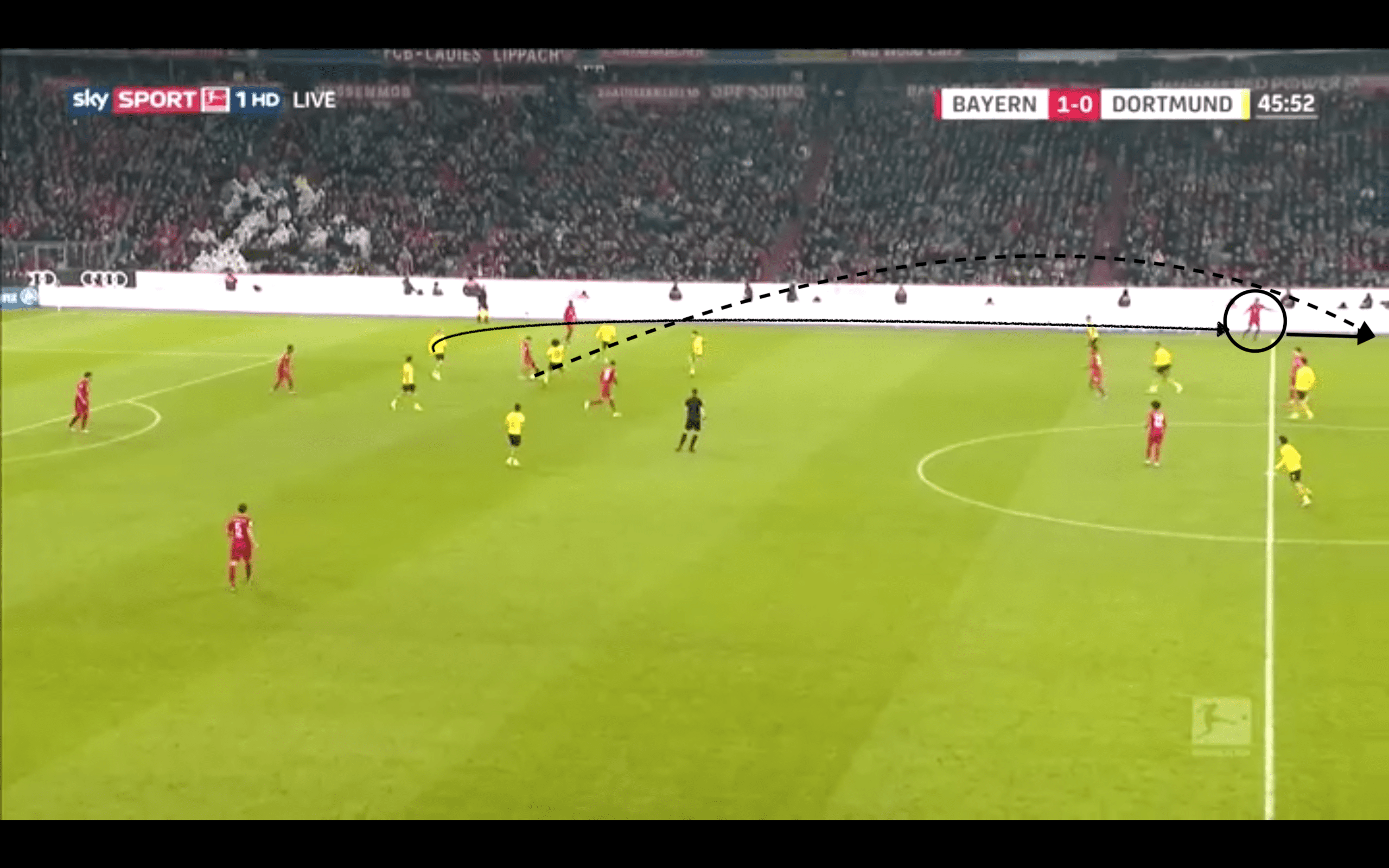
Müller is also able to find space all over the pitch and can be a useful counter-attacking threat as shown above. Despite his lack of pace and dribbling ability, his positioning and movement make up for it. In the example above, he quickly transitioned from helping the team defensively to finding space behind defenders who are focused on the ball. Joshua Kimmich is able to find Müller via a long ball and the attacker is able to progress the attack. Given his advantageous position, no Dortmund defender is able to get close to him without leaving Bayern players open. Müller takes full advantage of this and proceeds to play in Serge Gnabry who scores Die Roten’s second of the night.
Movement and intelligence
There are only a few players able to play the Raumdeuter role in world football and two key attributes a player who plays in such a role requires are movement and intelligence – traits that Müller has in abundance. He makes a variety of movements making it very hard to mark him. He likes to make runs off the shoulder of the last defender to go through on goal or drop in little pockets and link-up with his teammates.
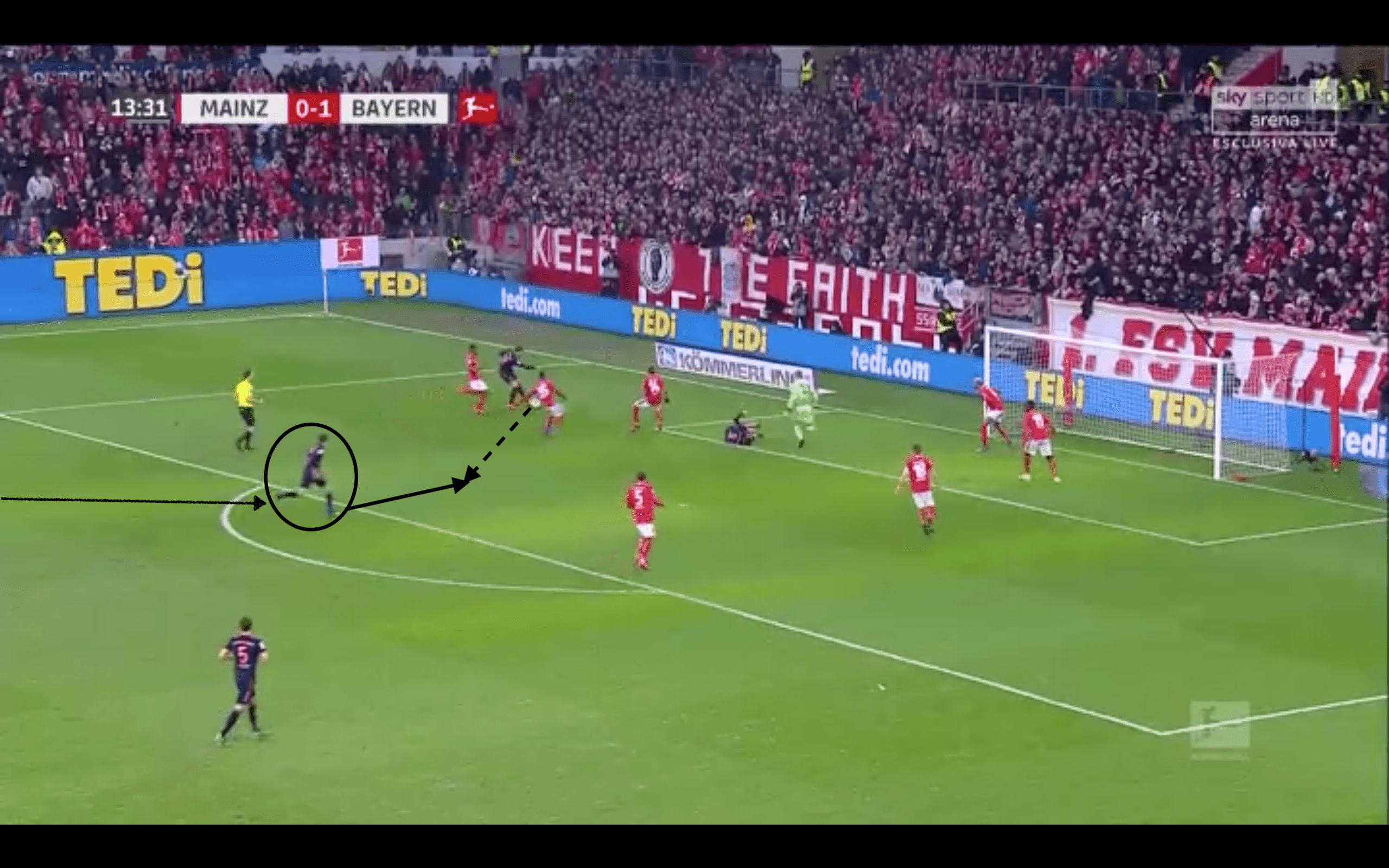
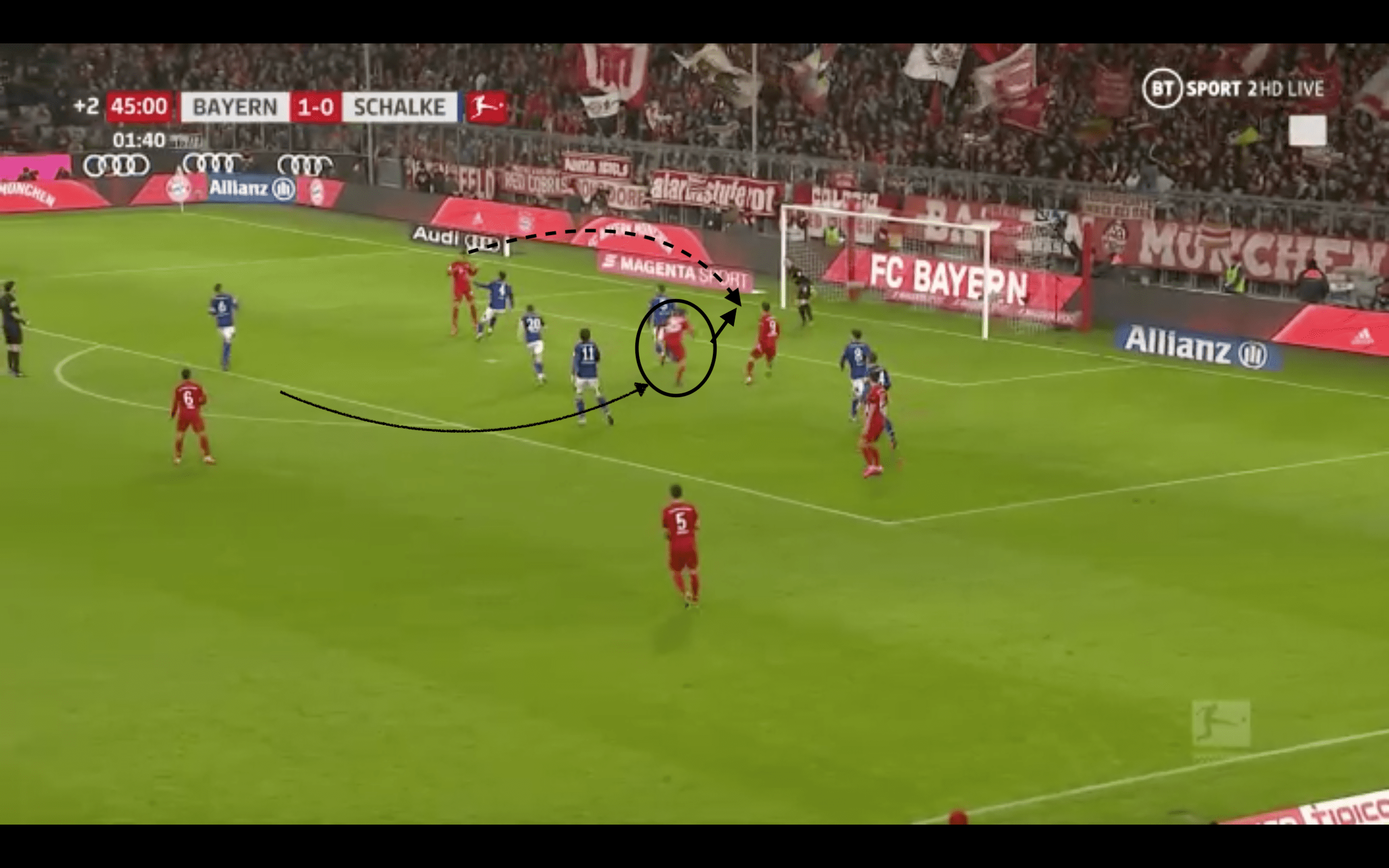
Here are two examples showing Müller’s striker’s instinctual movements that seem to have been lost in previous seasons given the decrease in his goal tallies over the years. The German makes runs to be in great goalscoring positions and his superb anticipation and footballing IQ means he knows where the passes are going to be. Both times, Leon Goretzka puts the ball back across goal for Müller to score. With Lewandowski the main goalscoring threat and the likes of Goretzka and Gnabry also able to score, Müller has been given the task of being one of the creators by Flick and is one of the reasons why he has more assists than goals under the new manager.
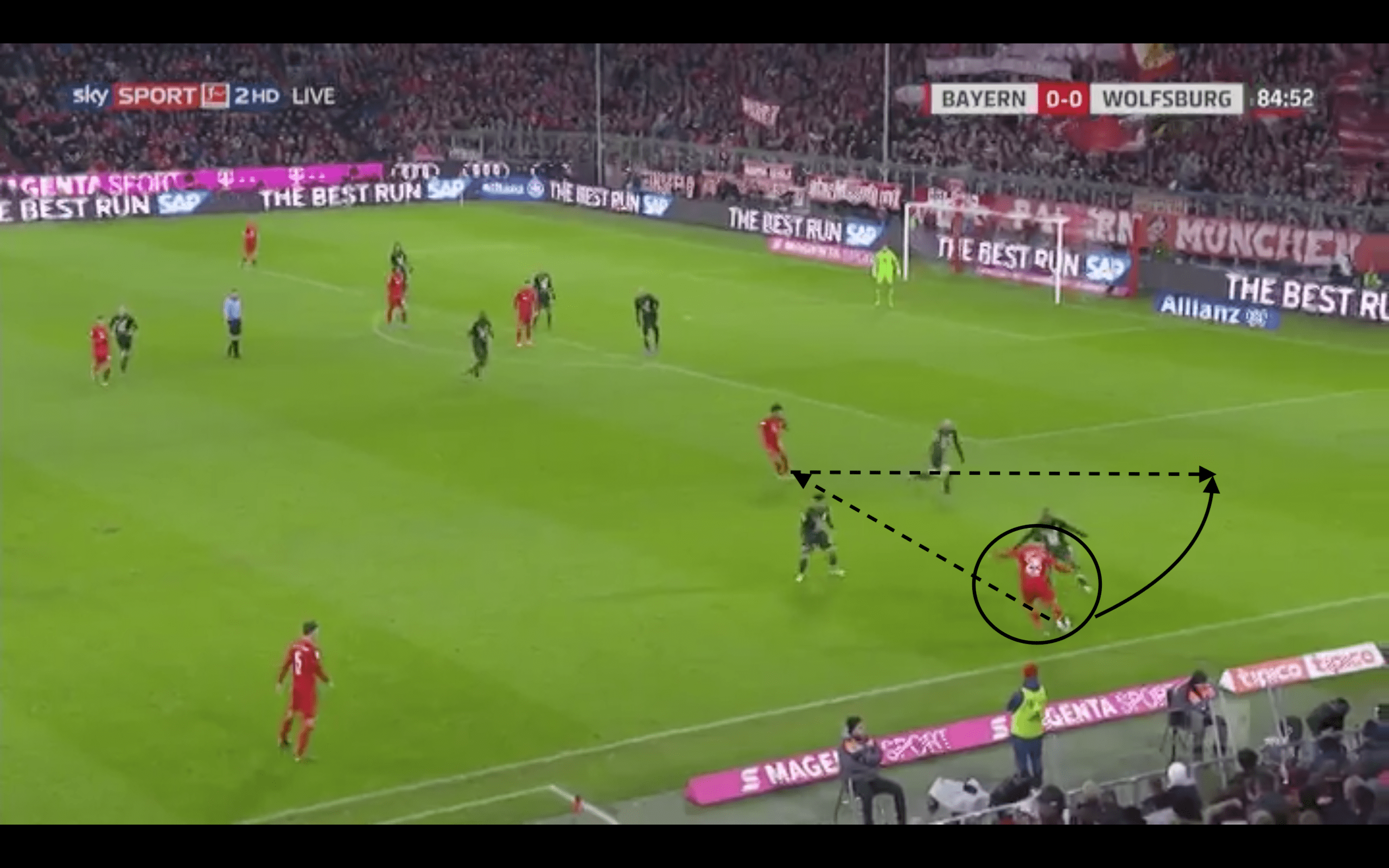
In this example, Müller showcases why he has been able to produce 16 assists in the Bundesliga. He plays a pass into Gnabry who has a great amount of space to drive into and does so often given his goalscoring nature. Müller makes a great run and capitalises on the opposition’s fatigue to ghost past the defender, which gives Bayern a 2vs1 situation. The ball is played back to Müller who himself pulls it back to Joshua Zirkzee who scores a crucial late goal. Normally the 30-year-old drifts into position but he is also capable of making great runs from a stationary position as shown above.
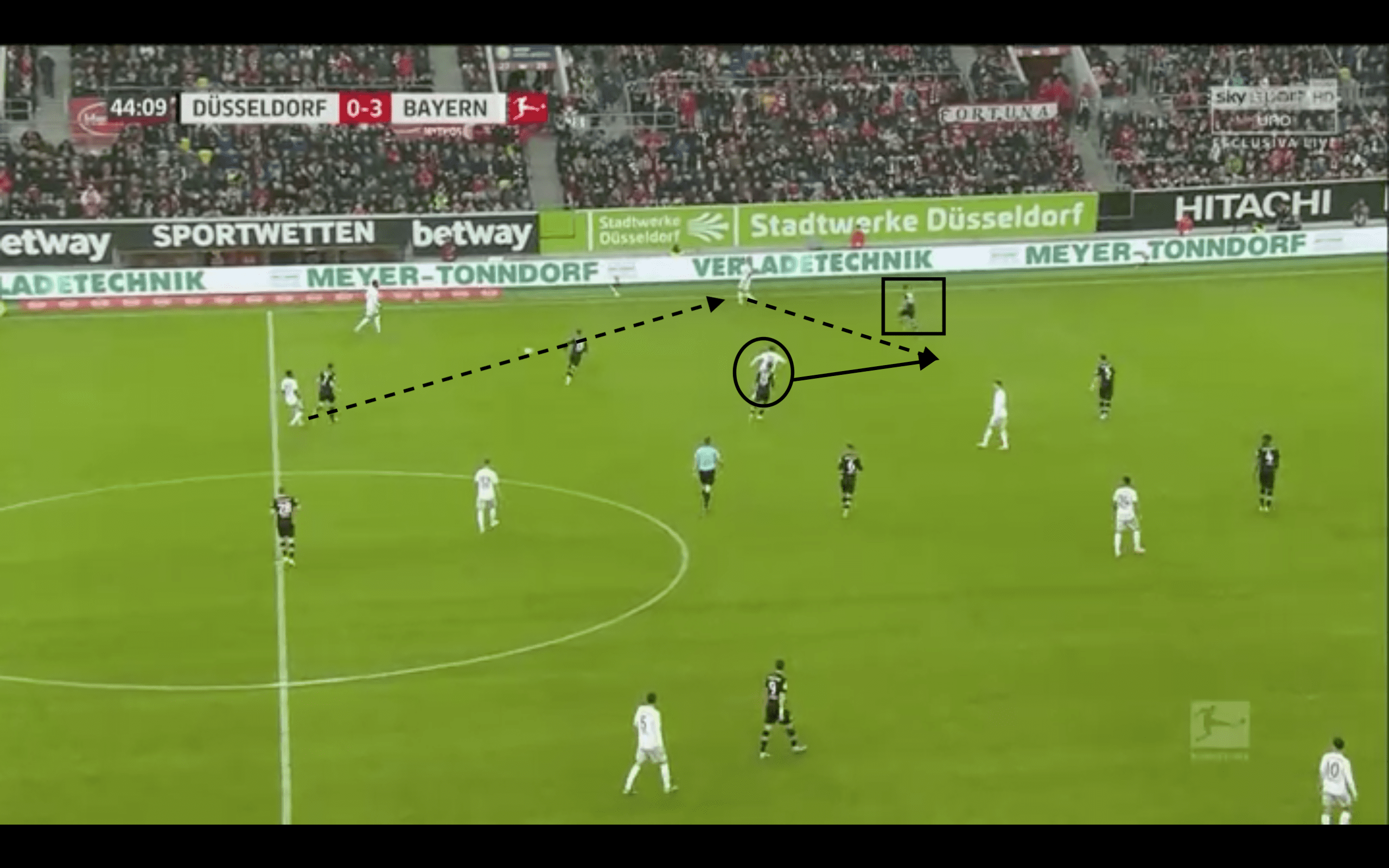
This example encapsulates Müller’s football brain as he is able to anticipate the move and stay a couple of steps ahead of the opposition. He already starts making a run when Alaba passes the ball meaning that he is able to get past his defender straight away. He moves into the space that is occupied by the right-back, annotated by a square, as he recognises that he will press Gnabry who is the receiver. The winger plays the pass into Müller who is now in a great area of space. Then, Gnabry makes a run into the space that Müller vacated but the attack fizzles out. These type of movements from the Bayern players and especially Müller has been a key reason for how flexible their attack has been under Flick – something that was missing under previous manager Niko Kovac.
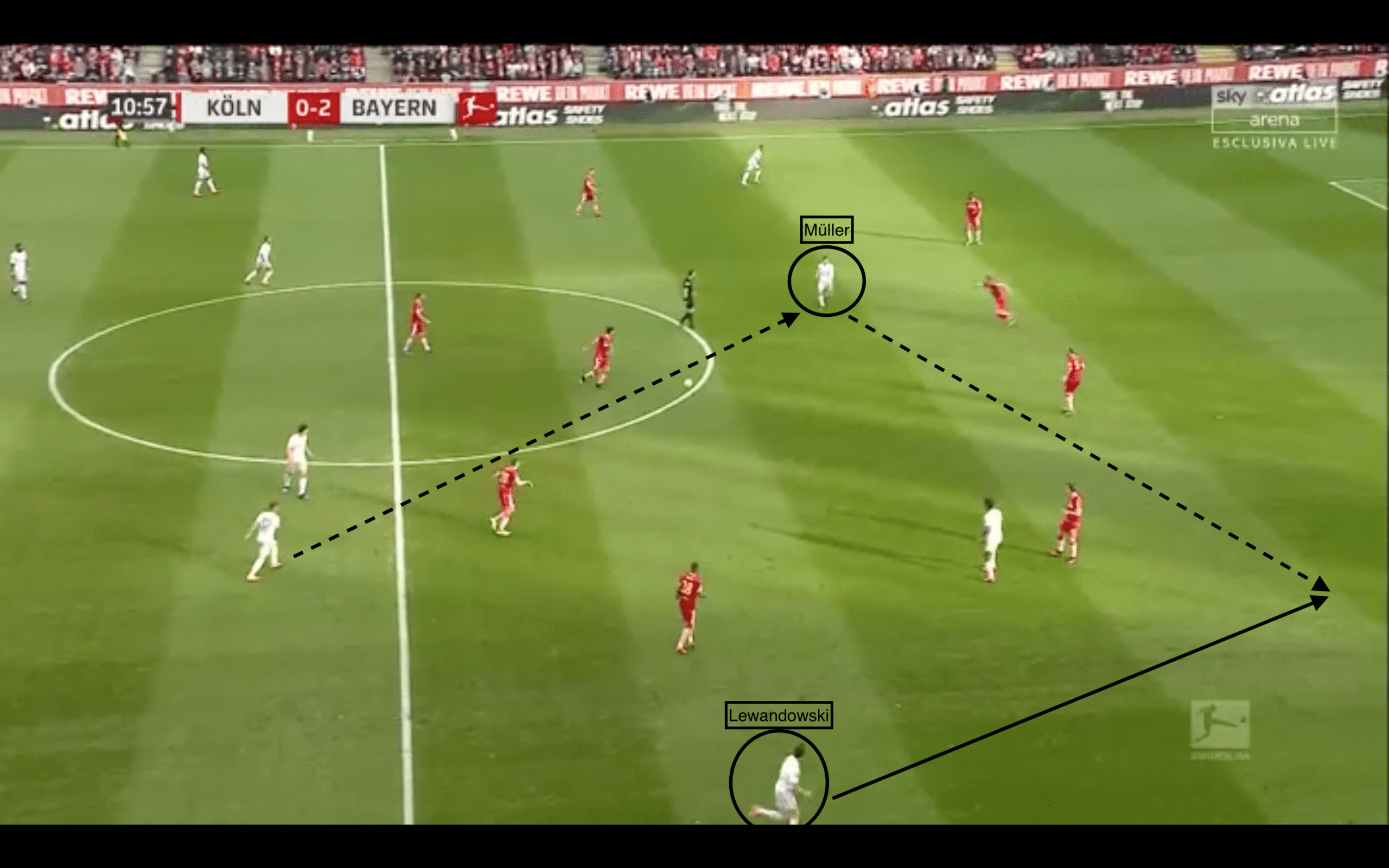
Müller’s intelligence doesn’t just limit to his movement as it is also evident in his decision making. Here, he drops in between the defence and midfield and finds some space. Similar to the example prior, Müller recognises Lewandowski’s run before receiving the pass from Kimmich. His technical ability might not be his greatest asset given his unorthodox style, but he is still an incredibly gifted footballer and is able to play a sensational first-time pass to Lewandowski. The first-time pass is a staple of Müller’s refined game and has been very effective this season.
Defensive contributions
Bayern Munich are blessed to have a lot of great midfielders with the likes of Corentin Tolisso, Thiago and Goretzka in their ranks. They signed Philippe Coutinho on loan in the summer and Niko Kovac refused to play both Coutinho and Müller due to the lack of balance. However, under Flick, they can both co-exist in the line-up because of Müller’s contribution on the defensive side whether that’s helping in the team’s high and aggressive press or tracking back.
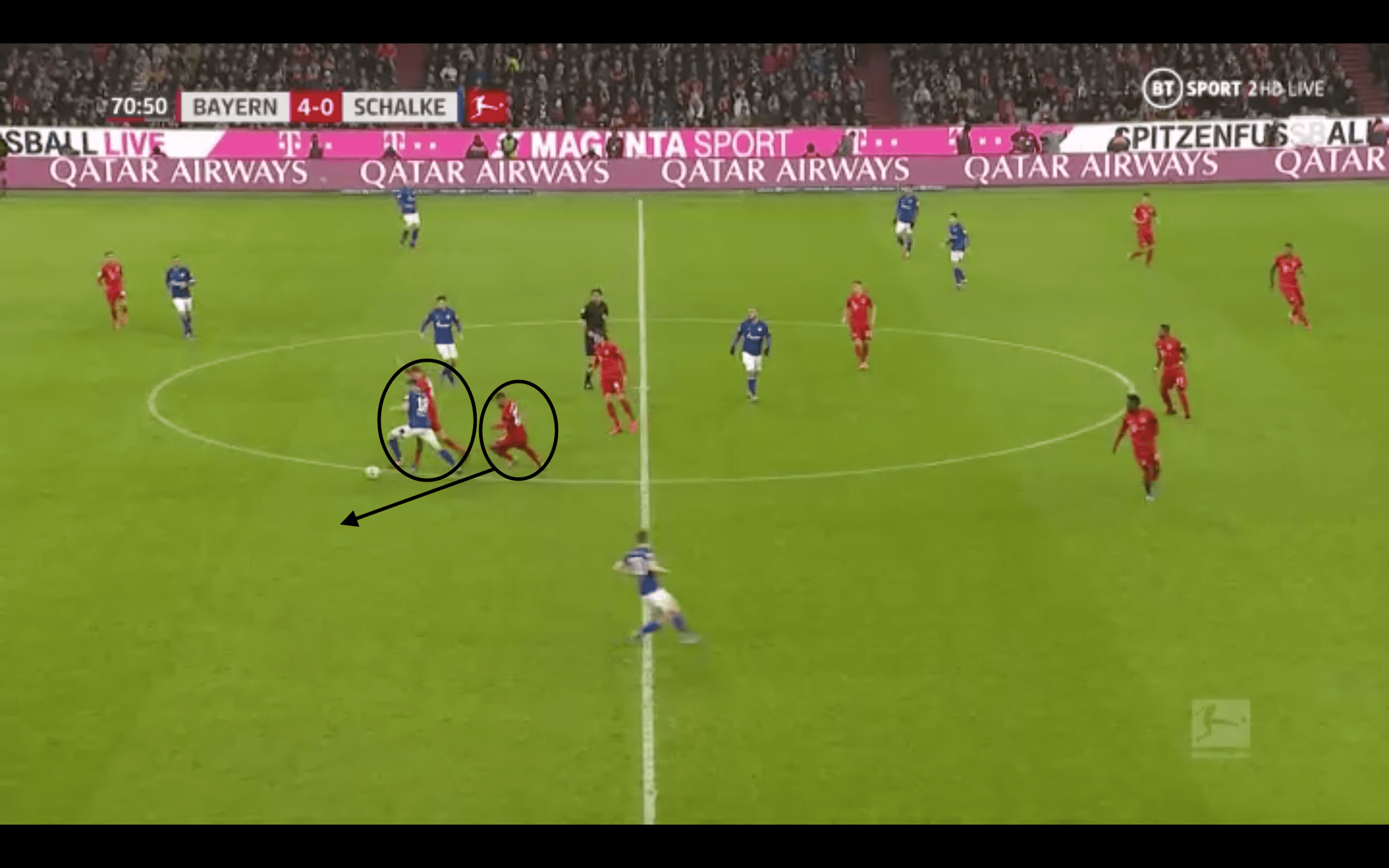
Here, Bayern are doubling up on a Schalke player with Müller and Gnabry to win the ball back. Müller successfully manages to win the ball back with Gnabry helping and running into space to be a passing option.
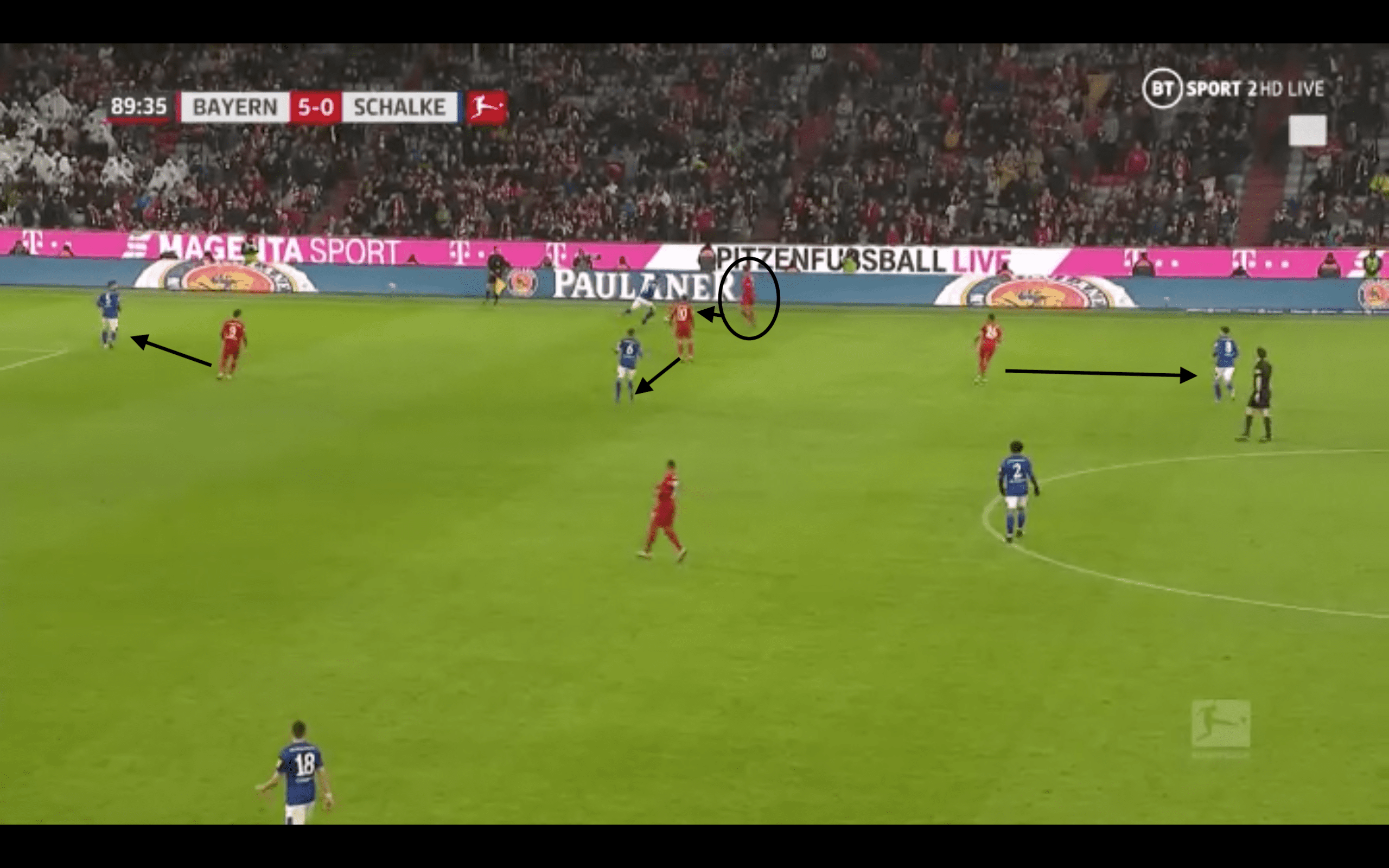
In this example, it shows Bayern’s advanced and aggressive team press with Müller closing down the Schalke player with the ball. With every passing option covered and Müller’s willingness to press, the Schalke player tries to go long only for his pass to ricochet of the 30-year-old and go out for a throw-in. Therefore, it must not come as a surprise that Müller is involved in 5.31 defensive duels per match.
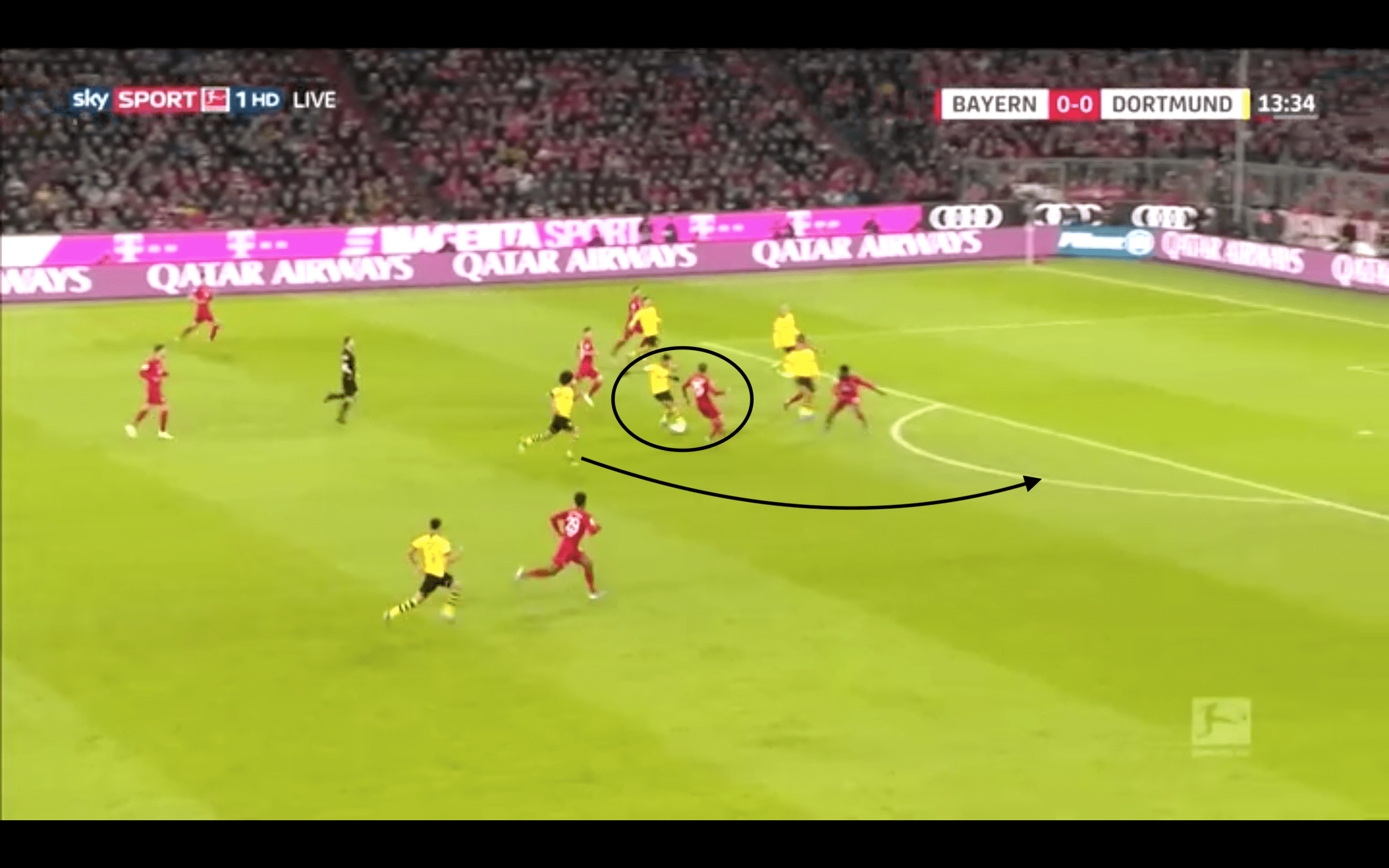
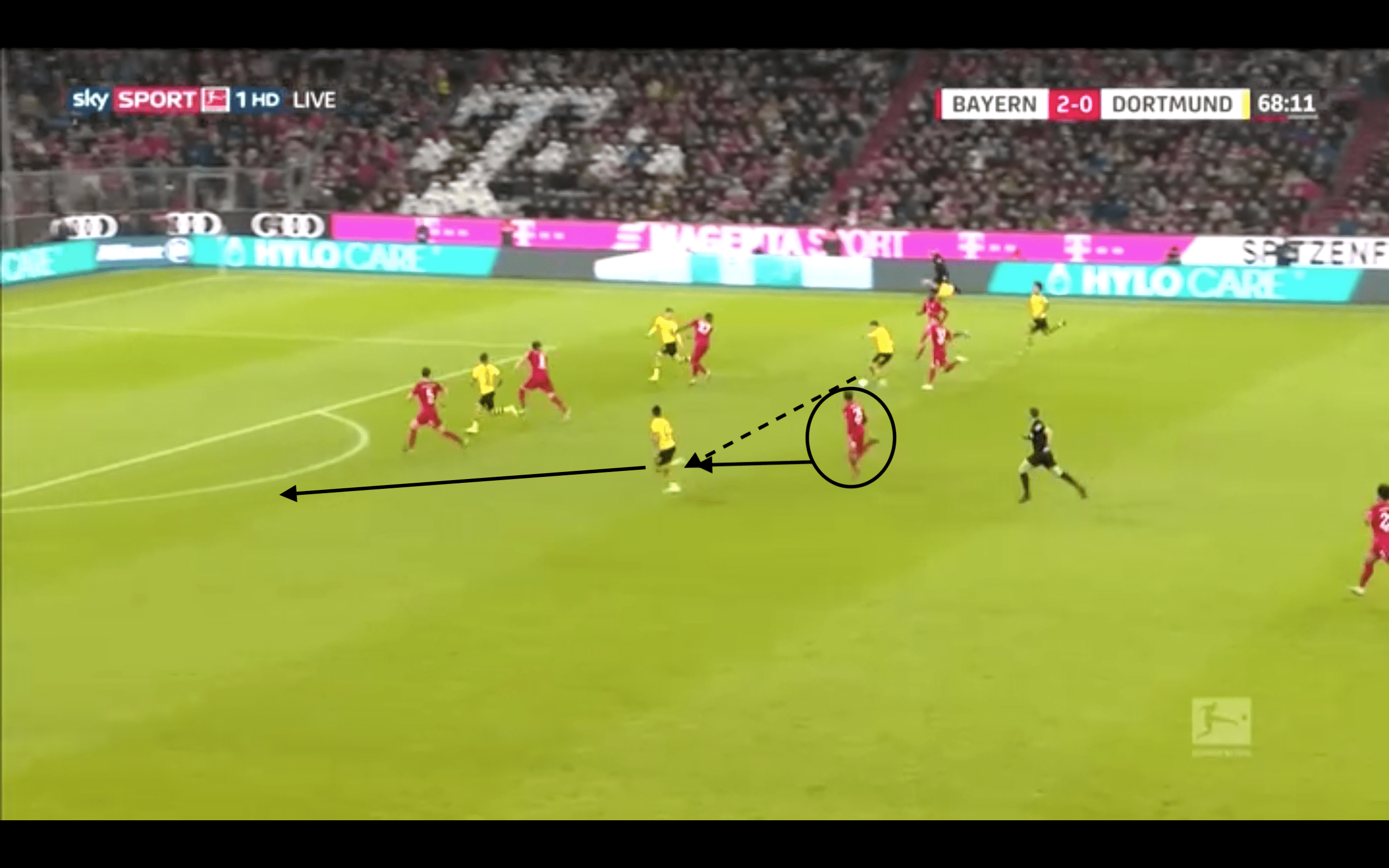
In both of these occasions, Müller is able to stop great goalscoring opportunities for Borussia Dortmund by tracking back. Both times, he is deep in Bayern’s half helping out the defence despite being an attacking player. In the first image, he is able to stop Axel Witsel from having a chance on goal by tackling the Dortmund player on the ball. Whereas in the second image, he makes a great interception so that Raphael Guerreiro can’t go through on goal. Bayern’s defence is their weak point but Müller’s desire to help in that area make him an indisputable starter under Flick.
Conclusion
After being heavily linked with an exit from his boyhood club just a couple of months ago, Thomas Müller’s resurgence under Hansi Flick has been a great sight to witness. Contributing to five goals and 12 assists in just 14 Bundesliga appearances is incredible but unsustainable. However, that is not to say that he can’t be one of the top contributors for Bayern Munich as shown by the analysis of his performances. With Flick playing Müller in a role that best suits him, the likes of Lewandowski and Gnabry will be huge beneficiaries in the near future. His exceptional footballing intelligence and movement are assets that many top teams around the world don’t have in players and thus, gives Flick and Die Roten a competitive edge over their rivals.




Comments